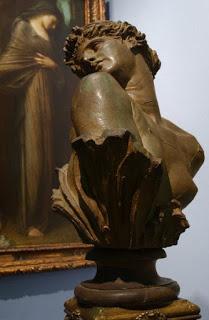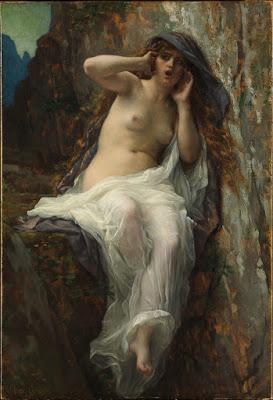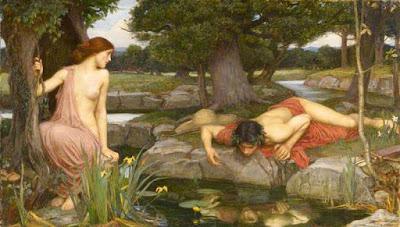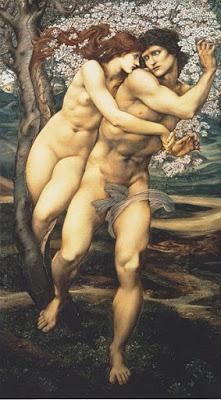
Apollo and Daphne (1908) John William Waterhouse
I was very lucky. Money could make me vanish from sight, but thinking about the anniversary I considered how many stories there are about women changing themselves in order to escape the interest of others. Daphne comes immediately to mind, transforming herself into a tree in order to escape the over-amorous Apollo. Fuelled by a spiteful arrow from Eros, Apollo is unable to control his lust. I gather the same is true of large quantities of alcohol.

Daphne (1898) Arthur Hacker
Daphne pleads to the Gods to save her from her attacker and they change her into a tree. This always seemed a little harsh to me as it seems a punishment on her for attracting attention rather than punishing Apollo for his unwanted advances. That's not to say she didn't have a long and very happy life as a tree. The birds perching on your branches, the squirrels frolicking up your trunk. Actually it sounds quite nice.
Clytie Evelyn de Morgan
There are other women who transform in myths, but rarely does it seem to be for a positive reason. Take Clytie, for example. Her beloved, Helios (the sun), cheated on her and so she got her rival buried alive thinking this would make Helios remember why he loved her. Yes, I know, looking back on it she could have handled that better. Anyway, she went out to a rock and sat there, stark naked staring up at the sun and waiting for him to return to her, which he never did. After nine days she transformed herself into a heliotrope (or sunflower/tournesol in French) whose flowers track the movement of the sun each day.
Clytie (1895) Frederic Leighton
Again it is a tale of a woman turned into flora, benign and harmless. Clytie's active attempts to attract Helios are replaced by a passive watch, whilst Daphne finds safety from sexual attack in the form of a tree. Is it the nullifying of sexual attraction and desire that these transformations result in, or something more specific to women? Is it the troubling matter of women's choice?
Clytie (1880s) G F Watts

Clytie (1865-9) G F Watts
I have always loved Watts view of Clytie, especially the sculptures where you can see the muscles and sinew stretch and twist as she attempts to follow the path of her lover, even as she is transforming. She is so possessed by her monomania that she is unaware that such a change is upon her. I would argue that if she was male, Helios would be the one transformed (although he is already the sun which is quite unattainable, as lovers go). The thing she has in common with Daphne is the presence of all-consuming desire which causes the woman in the situation to be 'made safe', made as sexless as a plant.
Echo G F Watts
Clytie wasn't the only transforming woman that Watts painted. Echo transformed twice in her myth. Firstly, possibly reflected in Watts' picture, she loses the ability to speak more than the last few words said to her which she is cursed to repeat. The myth tells that the goddess Hera, sick and tired of Zeus' many dalliances with nymphs, sought to catch him. Echo, a nymph who loved Zeus, tried to distract Hera with long conversations but when Hera worked out what she was doing took away her speech but for the last few words said to her.
Echo (1874) Alexandre Cabanel
Usually Echo just looks sad and resigned to her fate so it was interesting to find Cabanel's image of her realising what has been done to her and fighting pointlessly against the change. Echo's first transformation is again because of the dirty business of sex, whether she was the one who was rolling with Zeus or just covering up for his shenanigans. The removal of her voice was a punishment for being an accessory to extra-marital sex. Terrible in itself but worse was yet to come...
Echo and Narcissus (1903) John William Waterhouse
When Echo finally fell in love, she picked the sort of chap we all know so well. Narcissus was so beautiful that he only had eyes for himself and Echo could do nothing to woo him or tell him how she felt so her physical form faded away and she remained only a sound. He transformed into a flower that gazes forever into the water, although it seems a punishment for his folly rather than desire.These are in no way the only woman who are transformed in mythology, as metamorphoses are rife, be it the Heliades into poplar trees, Carya into a walnut tree, and Philyra into a linden tree (trees were popular, apparently). That leads me to the final transformation...

The Tree of Forgiveness (1881-2) Edward Burne-Jones
Phyllis loved her husband Demophon, but he was forced to ride away and help his father. When Phyllis gave up all hope of his return, she hanged herself from the branch of an almond tree. An almond tree sprang from her grave and when Demophon returned and embraced it in grief, Phyllis suddenly emerged from inside it, the passion she felt transforming her back into a woman. This is not a common ending to the story, usually only the tree merely blossoms or he never returns at all, but in Burne-Jones' dramatic painting the woman's transformation is one of empowerment, that her love sets her free and she can finally claim what she desires. He doesn't look so sure but then his dead wife has just exploded out of a tree and that does tend to take you back a bit. Through Burne-Jones we have transformation as victory rather than finale, a win rather than just an end, and more importantly the woman choose the time and form of her transformation.As for me, post-transformation, I am different but very much the same. My transformation gave me the confidence and peace to become me, blogger, writer, general chatterbox and good-for-nothing saucepot. It was undoubtedly one of the best things I ever did, although there may well be moments when Mr Walker would prefer to be married to a tree...

